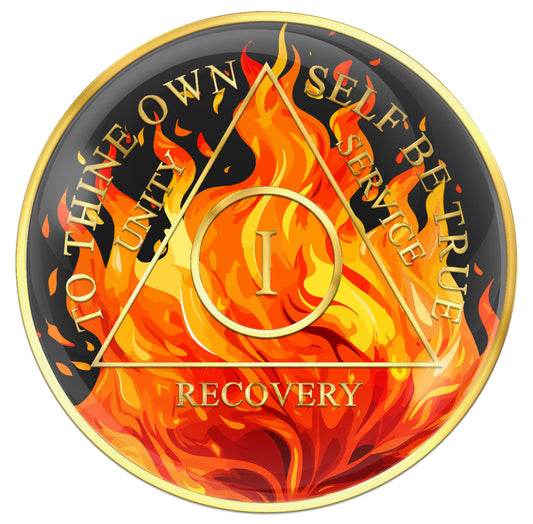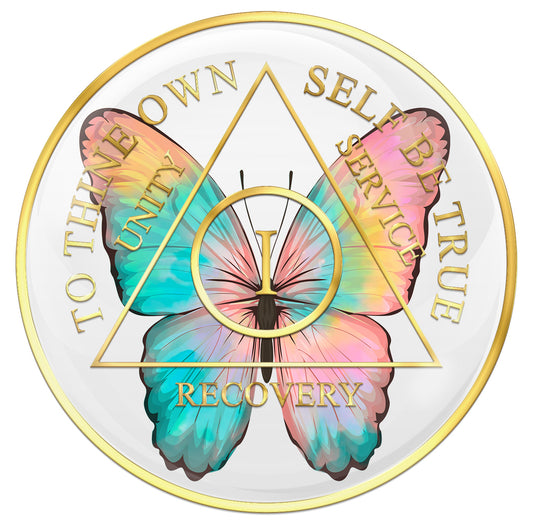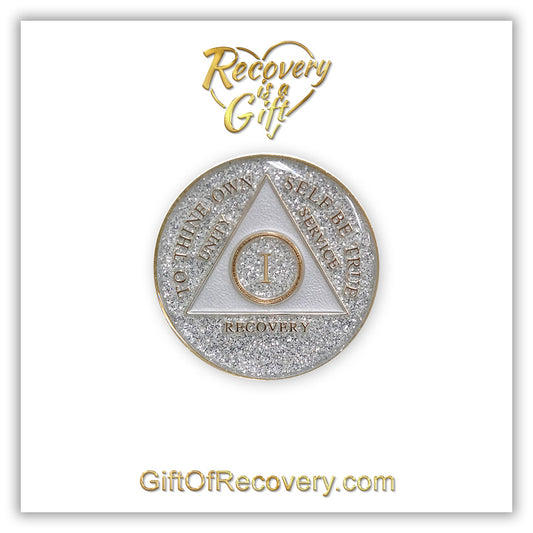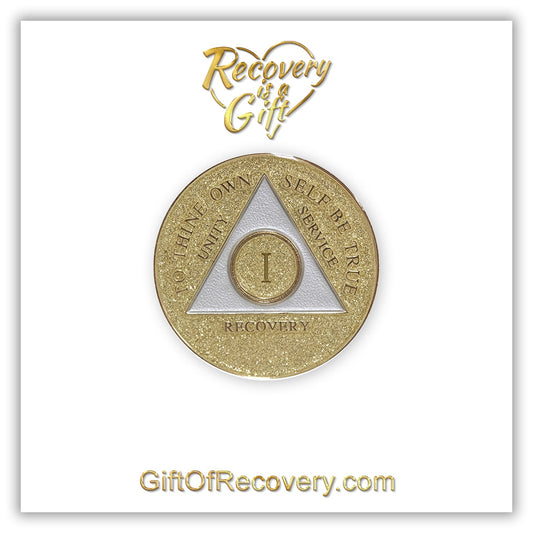
History Of The 12 Step AA Recovery Medallion
Share
“Chips” or sobriety tokens in Alcoholics Anonymous are poker-chip sized medallions that are awarded to members attending meetings to signify a specific milestone, normally a particular length of sobriety. Meetings that give out chips may offer ‘welcome chips’ to those attending their first meeting. Chips are traditionally made in specific colors for the first year of sobriety, which is earmarked by tokens given out for one, three, six and nine months. These chips are usually made of lighter weight materials like aluminum. An AA yearly anniversary or ‘birthday’ is marked by a medallion embossed with a Roman numeral designating a specific number of years. These are often made of brass or heavier metals. These days, it’s easy to find sobriety tokens ranging from one to fifty years sober! As the years have passed, a broad spectrum of fancy, embossed, and beautifully designed and decorated chips have become available, first at ‘Twelve Step’ stores, but now available on the internet in many iterations.
Although cherished, collected and appreciated by thousands AA members around the world, AA chips are not conference approved by Alcoholics Anonymous. From the outset, medallions, tokens, or sobriety coins have been manufactured and sold by private companies. Medallions are offered by meetings whose membership votes to purchase and publicly acknowledge their members for having maintained various lengths of recovery. Variously called tokens, chips, sobriety coins or medallions, AA chips are carried or collected as reminders of an AA member’s commitment to maintaining sobriety by using the Twelve Steps of recovery outlined in the Big Book of Alcoholics Anonymous. Other kinds of 12-Step meetings, those modeled on the AA way of facing and treating compulsive, addictive disorders, may also choose to acknowledge membership or lengths of recovery with abstinence chips. Narcotics Anonymous, Overeaters Anonymous, and other 12-Step program meetings may vote to reward their members with their own topic-specific medallions. Many different kinds of medallions are available on today’s market.
These days, the AA chip is usually the size of a poker chip, designed to be tucked into a pocket or carried in a coin purse by members. Some of them are designed to slide onto a key ring. Since it is not conference approved, rather than the AA logo, a typical sobriety chip has “To Thine Own Self Be True” embossed around the outside ring on one side of the chip. A triangle with the words “Service,” “Unity” and “Recovery” etched on each leg of the triangle details the three-pronged purpose of Alcoholics Anonymous. In the center, a length of recovery is inscribed, usually in Roman numerals. On the other side of the sobriety chip, the much-loved AA “Serenity Prayer” is embossed:
“God, grant me the serenity
To accept the things I cannot change
The courage to change the things I can
And the wisdom to know the difference.”
What’s The Origin Of Chips In AA?
The history of Alcoholics Anonymous is neatly summed up in a collection of stories told by early AA members in the Midwest, where AA got its start. One of the first AA meetings was said to have been begun in June, 1939, by a small group of men who decided to step away from the Oxford Group in Cleveland, Ohio. Dr. Bob did not deeply involve himself in the break itself, and Bill W. had written and likely agreed that an autonomous group without too much religion would be a better starting point for many alcoholics (Dr. Bob, p.161-170). Other small meetings began in Akron at about the same time. Significantly, the earliest members of AA were about to discover that it was the autonomy of the AA group itself and the members’ commitments to the meeting and each other that would turn out to be key in helping so many members find a meaningful and lasting sobriety. Clarence S. in Cleveland, maintaining an active correspondence with Bill Wilson, said of the first AA meeting in Cleveland, “There is nothing to disturb Bill or anyone else here now, and we really expect to do a lot of work….Our policy will be mainly this:…Not too much stress on spiritual business at meetings. Have discussions after meetings of any business or questions arising. Plenty of fellowship all the time.” (Dr. Bob, p. 167.) It turns out that the presence of a spiritual connection between members at an AA meeting was the likely bedrock of individual members’ ability to put together longer term sobriety.
The Early Years
The history of using sobriety tokens or medallions in early AA is less well documented. Because they serve as tangible reminders of sobriety to the sober person, medallions have always been popular. The history of giving out tokens to commemorate lengths of sobriety begins when AA does. Indeed, using tokens to commemorate sobriety actually predates the founding of AA itself. Earlier Temperance societies in the United States handed out religious medallions to men who pledged to quit drinking and sometimes to mark lengths of sobriety. There’s an early AA story about a guy in Indianapolis who decided to turn his poker chips into tokens, marking them to denote particular lengths of sobriety. Apparently, he’d quit gambling and wanted to creatively re-purpose the poker chips. Perhaps that’s why the earliest AA tokens were called “chips.”
The first recorded practice of giving sobriety tokens to alcoholics seeking help is the work of Sister Ignatia, who, along with Dr. Bob, opened the first treatment ward for alcoholics at St. Thomas Hospital in Ohio in the late 1930’s. This was a remarkable achievement because alcoholics were mostly considered too challenging to work with. The medical establishment had found them resistant to medical assistance, and saw them as a pitiful collection of helpless, hopeless folks who were near impossible to help. None of them could stop drinking for any considerable period of time. Most of them couldn’t go a week without a drink. Sister Ignatia was hopeful that, with patience and love, a medical solution mixed with spiritual sustenance could be found. It was her practice to get to know each man and add that ‘spiritual’ component to the medical aid Dr. Bob and sheworked to develop at St. Thomas. “Sister Ignatia gave each of her newly released patients a Sacred Heart medallion, which she asked them to return before they took the first drink.” (Dr. Bob, p. 195.) She also sometimes handed out St. Christopher medals, the Catholic Patron Saint of travelers who watches over the lost. It’s all the more remarkable that these early tokens allowed for a rag tag group of men (there were few women) to celebrate a spiritual recovery journey they were learning to take together. Sister Ignatia’s medallions pointed the way forward.
A second documented reference to the use of tokens in the early years (AA.org) is mentioned in a letter written in 1942 to Bill W.’s secretary Nell Wing from a man called Doherty. He reasoned that the regular practice of giving out chips and tokens in AA to mark anniversaries and milestones had certainly caught hold by 1942. In other words, a few years after AA members had been meeting regularly, with membership growing, meetings had been going long enough for members to have anniversaries they wanted to commemorate with a token. By 1942, he reasoned, plenty of members took tokens to celebrate milestones in sobriety. They mattered, these anniversaries. The longer sober members thus planted the seed for the newer members, who began to imagine the day that they, too, would be able to take a token to celebrate an anniversary. From the early days on, the tokens themselves became the medium that carries AA’s message of hope.
Medallions And Tokens In Today’s AA
In today’s diverse and well-attended meetings of Alcoholics Anonymous (now held world-wide), tokens and medallions are a regular part of the opening section of many meetings. There are “chip chicks” and “birthday guys” whose contribution to a meeting is to bring a cake or fruit bowl, to call for celebrants to stand and be acknowledged, to pass around congratulation cards for members to sign, or to hand out chips or medallions commemorating significant milestones of sobriety. Newcomer or “24 Hour” chips serve as a common means of welcoming new folks. An old-timer might tell the newcomer to “break that chip in half” before taking the next drink. (They’re made of aluminum, so even biting it won’t break it in half.) Aluminum medallions for 30, 60, and 90 days of continuous sobriety, and for six and nine months and 1 or more years are given to friends, partners and any member of a meeting that gives chips. Sober members of Alcoholics Anonymous are thus acknowledged for their willingness, growth and consistent sobriety. Giving out tokens at a meeting often creates a joyous, celebratory atmosphere. Staying sober looks like fun! Alcoholics Anonymous honors those members who stay sober one day at a time for longer and longer periods of time. In many meetings in the United States these days, members take chips for long-time continuous sobriety of thirty, forty and even fifty consecutive years. These sober people “walk the road of happy destiny” together without falling, free from the burden of compulsively drinking that plagued them. The tokens given to sober alcoholics are the visible markers of a physical recovery from alcoholism that has a decidedly spiritual hue.
The Latest Thing, Inc. (owner of giftofrecovery.com) has been around for over thirty years, so its history of developing chips and medallions for the Southern California market and then on the internet can be said to reflect the use of chips and medallions generally in AA and its sister 12-Step recovery programs.
Works Cited
Dr. Bob and the Good Oldtimers: A biography, with recollections of early A.A. in the Midwest. 1980. Alcoholics Anonymous World Services, Inc. New York, NY, 1980. Book.
“How Do I Get an AA Chip?” Find Recovery. Last modified July, 2021. Findrecovery.com. Web. Accessed August 6, 2021.
“Origin of AA Coins, Chips, Tokens or Medallions, FAQ.” The Anonymous Press. Anonpress.org. Web. Accessed August 6, 2021.
“Sobriety Coin.” Wikipedia, the free encyclopedia. Wiki.com. Accessed August 6, 2021.








